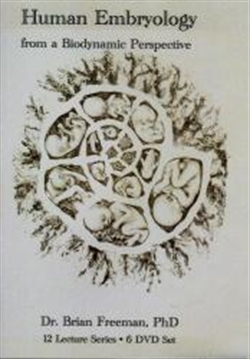
Human Embryology from a Biodynamic Perspective
6 DVD Set

Autor:
Dr. Brian Freeman, PhD.
These 12 lectures by Dr. Brian Freeman were filmed on July 3 and 4, 2010 in Bath, U.K. before an audience of 130 osteopaths. The material presented is essential for understanding the basic principles of embryology from a biodynamic perspective and is based on the work of Dr. Erich Blechschmidt. In a well documented and persuasive manner, Dr. Freeman gives an overview of embryology and its clinical importance. Lecturing without notes and in a conversational manner, this brilliant lecturer illuminates the embryological developmental processes while giving us a clear view of the sequencing and continuity of life unfolding. In these lectures he de-bunks many myths and misunderstandings of embryology that have led to confusion for most students. Dr. Freeman presents this material in a humorous and logical manner that communicates the depths of his understanding and creates metaphor and bodily connection with the developmental movements.
Each lecture is approximately 60 minutes long with an additional chapter of questions and answers from the audience.
CONTENTS:
Disc 1: 1) Early human development 1: The conceptus & biodynamic principles.
2) Early human development 2: The changing form of the embryo.
Disc 2: 3) Neural groove & spinal cord; neural crest, ectodermal ring & sensory dendrites.
4) Somites & motor neurites; musculoskeletal metabolic fields.
Disc 3: 5) Brain: flexures & ventricles; tectonics of cerebrum & cerebellum.
6) Craniofacial development: mesectoderm, pharynx, nose, meninges & skull.
Disc 4: 7) Fluid movements & heart: Development of position, form & structure.
8) a) Heart & major vessels: Introduction to endodermal derivatives.
b) Introduction to the viscera: foregut, midgut, hindgut.
Disc 5: 9) Growth-breathing: Development of lungs, larynx, trachea, paranasal sinuses.
10) Abdominal organs: Development of gastro-intestinal & renal functions.
Disc 6: 11) Growth-grasping & growth-kicking: development of limbs & joints.
12) Development of eye & ear. Final question and answer session.
Dr. Freeman is a retired professor from the University of New South Wales Anatomy Dept. and has spent most of his professional life teaching embryology and anatomy. He is the translator and editor for Erich Blechschmidt’s book, “The Ontogenetic Basis of Human Anatomy: A Biodynamic Approach to Development from Conception to Adulthood” and is considered one of the definitive spokespersons for Dr. Blechschmidt’s work. His brilliant teaching style clarifies and elucidates the complexities of embryological development.
Each lecture is approximately 60 minutes long with an additional chapter of questions and answers from the audience.
CONTENTS:
Disc 1: 1) Early human development 1: The conceptus & biodynamic principles.
2) Early human development 2: The changing form of the embryo.
Disc 2: 3) Neural groove & spinal cord; neural crest, ectodermal ring & sensory dendrites.
4) Somites & motor neurites; musculoskeletal metabolic fields.
Disc 3: 5) Brain: flexures & ventricles; tectonics of cerebrum & cerebellum.
6) Craniofacial development: mesectoderm, pharynx, nose, meninges & skull.
Disc 4: 7) Fluid movements & heart: Development of position, form & structure.
8) a) Heart & major vessels: Introduction to endodermal derivatives.
b) Introduction to the viscera: foregut, midgut, hindgut.
Disc 5: 9) Growth-breathing: Development of lungs, larynx, trachea, paranasal sinuses.
10) Abdominal organs: Development of gastro-intestinal & renal functions.
Disc 6: 11) Growth-grasping & growth-kicking: development of limbs & joints.
12) Development of eye & ear. Final question and answer session.
Dr. Freeman is a retired professor from the University of New South Wales Anatomy Dept. and has spent most of his professional life teaching embryology and anatomy. He is the translator and editor for Erich Blechschmidt’s book, “The Ontogenetic Basis of Human Anatomy: A Biodynamic Approach to Development from Conception to Adulthood” and is considered one of the definitive spokespersons for Dr. Blechschmidt’s work. His brilliant teaching style clarifies and elucidates the complexities of embryological development.
webová stránka:
sdílet